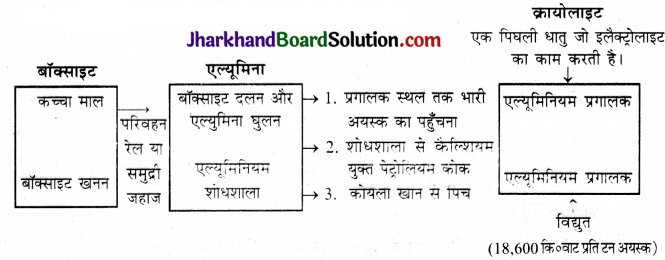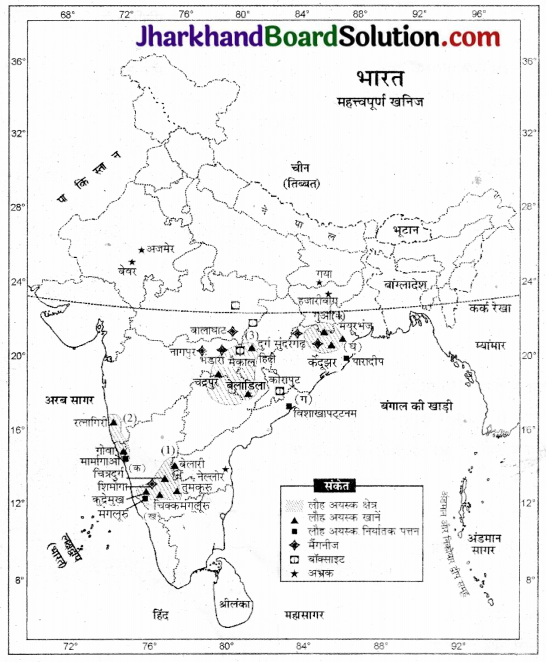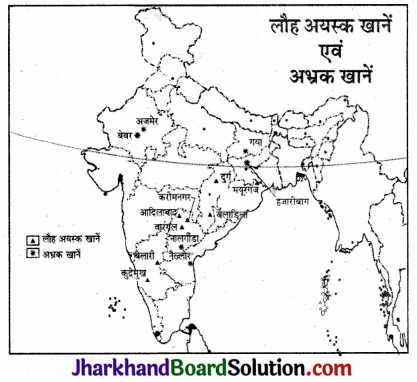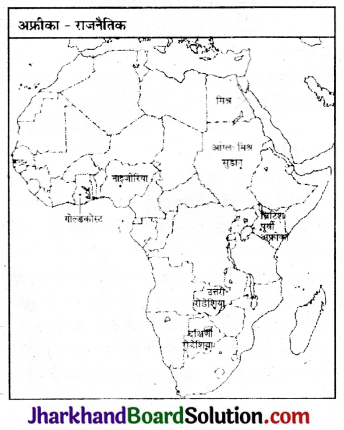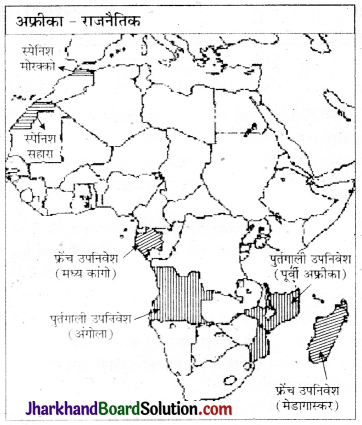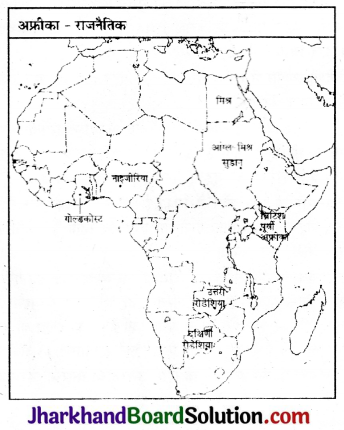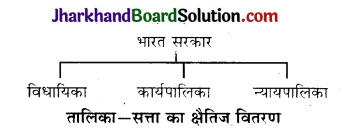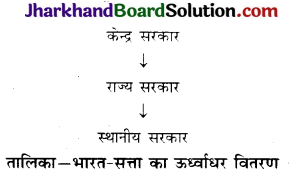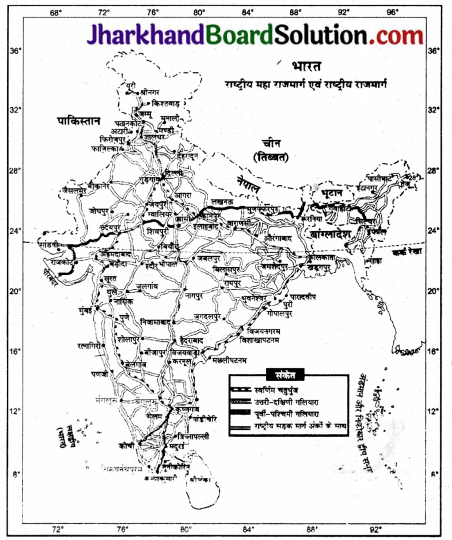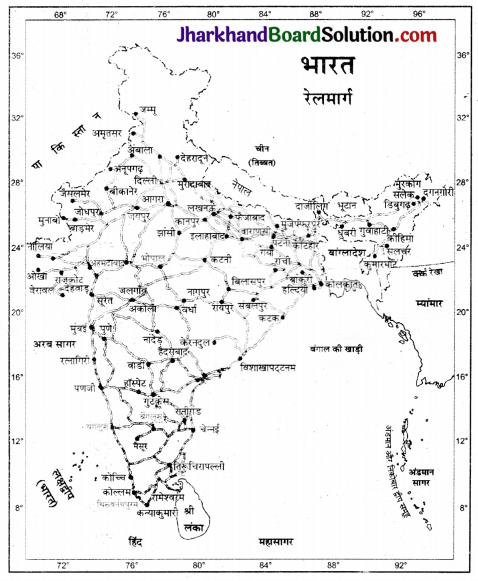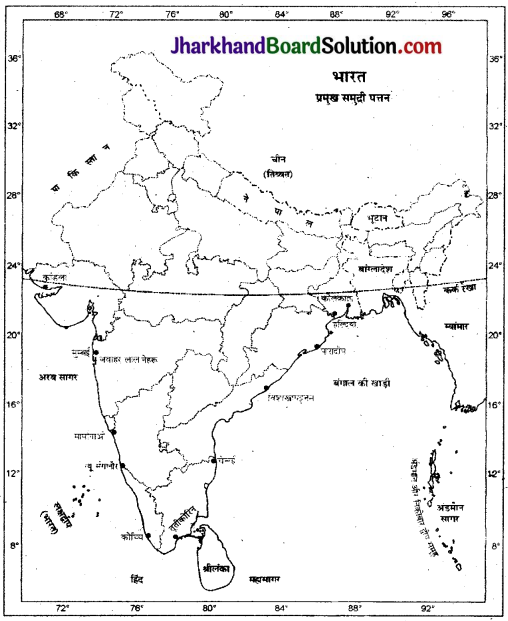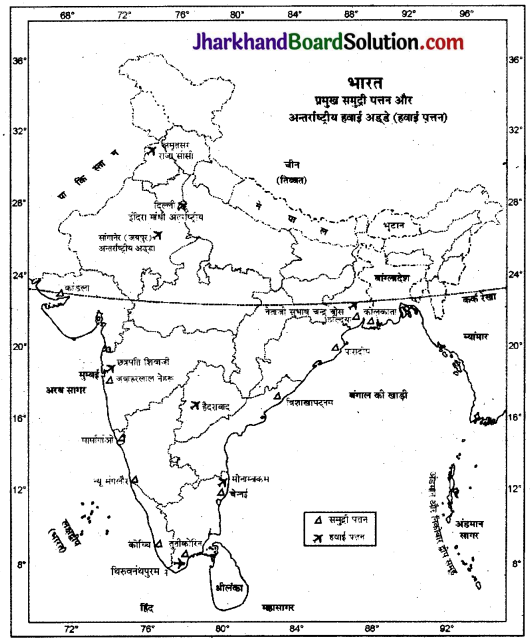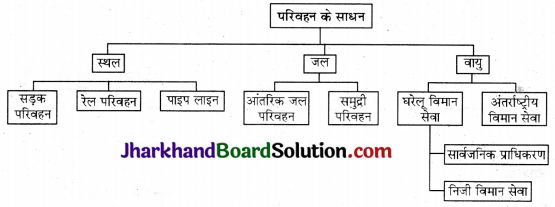JAC Board Class 10th Social Science Important Questions Geography Chapter 6 विनिर्माण उद्योग
वस्तुनिष्ठ
प्रश्न 1.
कच्चे पदार्थ को मूल्यवान उत्पाद में परिवर्तित कर अधिक मात्रा में वस्तुओं के उत्पादन को कहा जाता है
(क) विनिर्माण
(ख) उद्योग
(ग) निर्माण
(घ) व्यापार
उत्तर:
(क) विनिर्माण
2. निम्न में से कौन-सा कृषि आधारित उद्योग नहीं है?
(क) पटसन उद्योग
(ख) रबर उद्योग
(ग) सीमेंट उद्योग
(घ) चीनी उद्योग
उत्तर:
(ग) सीमेंट उद्योग
3. निम्नलिखित में से कृषि के पश्चात् किस उद्योग ने सबसे अधिक रोजगार प्रदान किए हैं?
(क) चीनी उद्योग
(ख) लोहा-इस्पात उद्योग
(ग) वस्त्र उद्योग
(घ) पटसन उद्योग
उत्तर:
(ग) वस्त्र उद्योग
![]()
4. चीनी मिलों का 60 प्रतिशत किन राज्यों में है?
(क) उत्तर प्रदेश व बिहार
(ख)बिहार व महाराष्ट्र
(ग) कर्नाटक व उत्तर प्रदेश
(घ) गुजरात व पंजाब
उत्तर:
(क) उत्तर प्रदेश व बिहार
5. निम्नलिखित में से कौन-सा आधारभूत उद्योग है?
(क). लोहा इस्पात
(ख) ताँबा प्रगलन
(ग) एल्यूमिनियम प्रगलन
(घ) उपरोक्त सभी
उत्तर:
(घ) उपरोक्त सभी
6. लोहा-इस्पात उद्योग के लिए कच्चे माल के रूप में लौह अयस्क, कोकिंग कोल एवं चूना पत्थर का क्रमशः अनुपात आवश्यक है
(क) 4 : 1 : 2
(ख) 4 : 2 : 1
(ग) 6 : 3 : 2
(घ) 3 : 2 : 5
उत्तर:
(ख) 4 : 2 : 1
7. उत्तेजना एवं मानसिक चिंता का स्रोत है
(क) ध्वनि प्रदूषण
(ख) वायु प्रदूषण
(ग) तापीय प्रदूषण
(घ) जल प्रदूषण
उत्तर:
(क) ध्वनि प्रदूषण
रिक्त स्थान सम्बन्धी प्रश्न
निम्नलिखित रिक्त स्थानों की पूर्ति कीजिए:
1. विनिर्माण क्षेत्र का विकास करने के लिए भारत सरकार ने राष्ट्रीय……की स्थापना की
उत्तर:
विनिर्माण प्रतिस्पर्धा परिषद्
2. भारत………को सूत निर्यात करता है।
उत्तर:
जापान,
3. भारत……..एवं……….सामान का सबसे बड़ा उत्पादक देश है। ..
उत्तर:
पटसन, पटसन निर्मित,
4. भारत का पहला सीमेंट उद्योग सन्………में. चेन्नई में स्थापित किया गया है।
उत्तर:
1904,
5. बंगलूरू को भारत की……….के रूप में जाना जाता है।
उत्तर:
इलेक्ट्रॉनिक राजधानी
अति लघूत्तरात्मक प्रश्न
प्रश्न 1.
किसी देश की आध्थिक उन्नति किन उद्योगों के विकास से मापी जाती है ?
उत्तर:
किसी देश की अर्थिक उन्नति विनिर्माण उद्योंगों के विकास से मापी जाती है।
प्रश्न 2.
राष्टीय विनिमाण प्रतिस्पधाँ परिषद् की स्थापना क्यों की गई है?
उत्तर:
देश की आर्थिक उन्नति में बृद्धि करने के लिए ताकि विनिर्माण उद्योग अपना लक्ष्य पूरा कर सकें
![]()
प्रश्न 3.
प्रयुक्त कच्चे माल के स्रोत के आधार पर विनिर्माण उद्योगों को वर्गीकृत्त कीजिए।
उत्तर:
प्रयुक्त कच्चे माल के स्रोत के आधार पर विन्माण उद्नोग दो प्रकार के होते है
- कृषि आध्रारित,
- खनिज आधारित।
प्रश्न 4.
कोई दो खनिज आथारित उद्धोग बताइए।
उत्तर:
खनिज आधारित उस्रोग
- लोहा एवं इस्पात उद्योग,
- सीमेंट उद्योग।
प्रश्न 5.
आधारभूत उद्धोग क्या है?
उत्तर:
वह उद्योग जिनके उत्पादन पर दूसरे उहोग निर्भर रहंते हैं, आधारभूत उद्योग कहलाते हैं।
प्रश्न 6.
उपभोक्ता उद्योग किन्हें कहते हैं?
उत्तर:
बे उद्योग जो उपभोक्ताओं के सीधे उपभोग हैतु उत्पाद्न करते है, उपभोकता उद्योग कहलाते है
प्रश्न 7.
पूँजी निवेश के आधार पर उद्मोगों को कितने में बाँटा जा सकता है?
उत्तर:
पूँजी निवेश के आधार पर उद्योगों को दो भागों में बॉटा जा सकता है:
- लघु उद्योग,
- वृहत उद्योग।
प्रश्न 8.
स्वामित्व के आधार पर उद्योर्गों को कितने भागों में बाँटा जा सकता है?
उत्तर:
स्वामित्व के आधार पर उद्योगों को तीन भार्गों में बाँटा जा सकता है
- सार्वरनिक क्षेत्र के उद्योग,
- संयुक्त उद्योग,
- सहकारी उद्योग।
प्रश्न 9.
सार्वजनिक उद्योग क्या है?
उत्तर:
धे उद्योग जो सरकार द्वारा निर्यंत्रित एवं संदालित होते है, सार्ब्जनिक उद्योग कहलाते हैं।
![]()
प्रश्न 10.
सार्यंजनिक क्षेत्र के उद्योग के कोई दो उदाहरण दीजिए।
उत्तर:
सार्वजनिक क्षेत्र के उद्योग के उदाहरण-
- भारत हैवी इलैक्ट्रकल लिमिटेड (BHEL),
- स्टील अथारिटी ऑफ इण्डिया लिमिटेह (SAIL)
प्रश्न 11.
संयुक्त उद्धोग किसे कहते हैं?
उत्तर:
राज्य सरकार व निजी क्षेत्र के संखुक्त प्रयास से चलाये जाने वाले उद्योगों को संखुक्त उद्रोग कहते हैं।
प्रश्न 12.
सहकारी उद्योग किन्हें कहते है?
उत्तर:
वे उद्योग जिनका स्वामित्व कचे माल की पूर्ति करने वाले उत्पादकों, भ्रमिकों अथवा दोरों के हलथों में होता है, सहकारी उद्होग कहलाते हैं।
प्रश्न 13.
कृषि आधारित उद्योग किहें कहते हैं?
उत्तर:
चे उद्घोग जिन्हे अपना कच्चा माल कृषि से प्राप्त होता है; कृषि आधारित उद्योग कहलाते हैं।
प्रश्न 14.
भारत का पहला सफल सूती वस्त्र उद्योग कद्य व कहोँ लगा था?
उत्तर:
भारत का पहला सफल सूती वस्त्र उद्योग सन् 1854 में मुम्बईई में लगा था।
प्रश्न 15.
भारत में किन राज्यों में सूती वस्त्न उद्धोग का सर्वाजिक विकास हुआ है?
उत्तर:
भारत के महाराष्ट्र एवं गुजरात राज्यों में सूती बस्त्र उयोग का सर्वाधिक विकास हुआ है।
![]()
प्रश्न 16.
किन्हीं दो देशों के नाम बताइए जो भारत से सूती वस्त्रों का आयात करते है?
उत्तर:
भारत से सूती वस्तों का आयात करने वाले देश:
- जापान,
- संयुक्त राज्य अमेरिका ।
प्रश्न 17.
पटसन वा पटसन निर्मित सामान का सबसे बड़ा उत्पादक है तथा बांग्लादेश के पश्चात् दूसरा बड़ा निर्चाँतक भी है।
उत्तर:
भारत।
प्रश्न 18.
प्रथम पटसन उद्योग कहाँ व कद्य स्थापित्त किया गाया?
उत्तर:
प्रथम पटसन उद्योग कोलकाता के निकट रिशरा में 1855 है. नें स्थापित किया गया।
प्रश्न 19.
विश्व स्तर पर भारत का चीनी उत्तादन में कौन-सा स्थान है?
उत्तर:
विश्व स्तर पर भारत का चीनी उत्पदन में द्वितीय स्थान है।
प्रश्न 20.
पिछले कुछ वर्षों से दब्षिणी-पशिचमी राज्यों में चीनी मिलों की बकृती हुई संख्या का क्या कारण है?
उत्तर:
- दक्षिण-पशिचम भारत के गन्ने में सूक्रोस की मात्रा का अधिक होना।
- दक्षिण-पश्चिम भारत की जलवायु का अपेक्षाकृत उण्डा होना ।
प्रश्न 21.
लोहा-इस्पात उद्योग को आधारभूत उद्योग क्यों कहा जाता है?
उत्तर:
क्योंकि अन्य सभी भारी, हल्के पवं मध्यम उद्योग लोहा-इस्पात उद्योग से बनी मशीनरी पर निर्भर होते हैं।
प्रश्न 22.
लोहा-इस्पात उद्योग के लिए आवश्यक कच्चा माल कौन-कौन सा है?
उत्तर:
लोहा-इस्पात उद्योग के लिए-आवश्यक कच्चा माल लौह अयस्क, कोकिंग कोल, चूना पत्थर एवं मेंगनीज़ हैं।
प्रश्न 23.
इस्पात को कठोर बनाने के लिए किस खनिज की आवश्यकता होती है?
उत्तर:
इस्पात को कठोर बनाने के लिए मैंगनीज़ की आवश्यकता होती है।
![]()
प्रश्न 24.
इस्पात का सबसे बड़ा उपभोक्ता एवं उत्पादक देश कौन-सा है?
उत्तर:
इस्पात का सबसे बड़ा उपभोक्ता एवं उत्पादक देश चीन है।
प्रश्न 25.
भारत का द्वितीय सर्वाधिक महत्वपूर्ण धातु शोधन उद्योग कौन-सा है?
उत्तर:
भारत का द्वितीय सर्वाधिक महत्वपूर्ण धातु शोधन उद्योग ऐल्यूमिनियम प्रगलन है।
प्रश्न 26.
………….. उद्योग का उपयोग हवाई जहाज बनाने में, बर्तन तथा तार बनाने में किया जाता है।
उत्तर:
ऐल्यूमिनियम।
प्रश्न 27.
ऐल्युमिनियम किससे निम्मित होता है?
उत्तर:
ऐल्यूमिनयिम बॉक्साइट से निर्मित होता है।
![]()
प्रश्न 28.
अकार्बनिक रसायनों के कोई दो उदाहरण दीजिए।
उत्तर:
अकार्बनिक रसायनों के उदाहरण-
- सल्फ्यूरिक अम्ल,
- नाइट्रिक अम्ल।
प्रश्न 29.
पेट्रो रसायन का क्या उपयोग है?
उत्तर:
पेट्रो रसायन कृत्रिम रबर, प्लास्टिक, रंजक पदार्थ, दवाइयाँ, औषध रसायनों के निर्माण में प्रयुक्त किया जाता है।
प्रश्न 30.
चूना पत्थर, सिलिका, एल्युमिना और जिप्सम ………… उद्योग के कच्चे माल हैं।
उत्तर:
सीमेंट।
प्रश्न 31.
सीमेंट बनाने के लिए काम में आने वाले किन्हीं दो कच्चे मालों का नाम लिखिए।
उत्तर:
सीमेंट बनाने में काम में आने वाले कच्चे माल
- चूना पत्थर,
- सिलिका,
- जिप्सम आदि हैं।
प्रश्न 32.
कौन-सा शहर भारत की इलैक्ट्रॉनिक राजधानी कहलाता है?
उत्तर:
बंगलौर (बैंगलूरु) भारत की इलैक्ट्रॉनिक राजधानी कहलाता है।
प्रश्न 33.
कर्नाटक राज्य में स्थित प्रसिद्ध सॉफ्टवेयर प्रौद्योगिकी पार्क का नाम लिखिए।
उत्तर:
बंगलौर (बैंगलूरु)।
प्रश्न 34.
उद्योग कौन-कौन से प्रदूषण के लिए उत्तरदायी हैं?
उत्तर:
उद्योग चार प्रकार के प्रदूषण के लिए उत्तरदायी हैं:
- वायु,
- जल,
- भूमि एवं
- ध्वनि प्रदूषण।
प्रश्न 35.
जल प्रदूषण के प्रमुख कारक कौन-कौन से हैं?
उत्तर:
जल प्रदूषण के प्रमुख कारकों में कागज, लुग्दी, रसायन, वस्त्र व रैंगई उद्योग, तेलशोधन शालाएँ, चमड़ा उद्योग एवं इलेक्ट्रॉप्लेटिंग उद्योग आदि हैं
![]()
प्रश्न 36.
कारखानों द्वारा निष्कासित एक लीटर अपशिष्ट से कितना जल दूषित होता है?
उत्तर:
कारखानों द्वारा निष्कासित एक लीटर अपशिष्ट से लगभग आठ गुना स्वच्च जल दूषित होता है।
प्रश्न 37.
भारत में विद्युत प्रदान करने वाले प्रमुख निगम का नाम लिखिए।
उत्तर:
भारत में राष्ट्रीय ताप विद्युत गृह कॉरपोरेशन विद्युत् प्रदान करने वाला मुख्य निगम है।
लयूत्तरात्मक प्रश्न (SA1)
प्रश्न 1.
विनिर्माण उद्योग को आर्थिक विकास की रीढ़ क्यों कहा जाता है?
अथवा
भारतीय अर्थव्यवस्था के लिए विनिर्माण उद्योगों का क्या महत्व है?
अथवा विनिर्माण उद्योग के महत्व को स्पष्ट कीजिए।
उत्तर:
विनिर्माण उद्योग को निम्न कारणों से विकास की रीढ़ माना जाता है
- यह द्वितीयक एवं तृतीयक सेवाओं में रोजगार के अवसर उपलब्ध कराकर कृषि पर जनसंख्या की निर्भरता को कम करता है।
- देश के विभिन्न भागों में स्थापित बिनिर्माण उद्योग लोगों को रोजगार उपलब्ध कराकर गरीबी को कम करने का प्रयास करते हैं।
- जनजातीय एवं पिछड़े क्षेत्रों में स्थापित विनिर्माण उद्योग क्षेत्रीय असमानताओं को कम करने में सहायक होते हैं।
- विनिर्माण उद्योगों से प्राप्त उत्पादों के निर्माण से व्यापार और वाणिज्य का विस्तार होता है तथा देश को विदेशी मुद्रा प्राप्त होती है।
प्रश्न 2.
निजी एवं सहकारी क्षेत्र के उद्योगों में अन्तर स्पष्ट कीजिए। उत्तर-निजी एवं सहकारी क्षेत्र के उद्योगों में निम्नलिखित अन्तर हैं
| निजी क्षेत्र के उद्योग | सहकारी क्षेत्र के उद्योग |
| 1. इन उद्योगों का स्वामित्व किसी व्यक्ति, फर्म अथवा समूह के पास होता है। | 1. ये उद्योग कुछ लोगों के समूह द्वारा सहकारिता के आधार पर चलाए जाते हैं। |
| 2. इन उद्योगों में व्यक्ति. फर्म अथवा समूह पूँजी का निवेश करते हैं। | 2. इन उद्योगों में हिस्सेदार पूँजी का निवेश करते हैं। |
| 3. इन उद्योगों में लाभ या हानि व्यक्ति, फर्म अथवा समूह को होती है। | 3. इन उद्योगों में लाभ-हानि का विभाजन हिस्सेदारों में भी आनुपातिक होता है। |
प्रश्न 3.
सूती वस्त्र उद्योग किस प्रकार से स्थानीय लोगों के लिए लाभदायक है?
उत्तर:
सूती वस्त्र उद्योग कृषि से जुड़ा हुआ उद्योग है। यह उद्योग किसानों, कपास चुनने वालों, गाँठ बनाने वालों, कताई करने वालों, रँगाई करने वालों, डिज़ायन बनाने वालों, पैकेट बनाने एवं सिलाई करने वालों को आजीविका प्रदान करता है। इस तरह सूती वस्त्र उद्योग स्थानीय लोगों को अधिक से अधिक संख्या में रोजगार उपलब्ध कराकर उन्हें लाभ पहुँचाता है।
प्रश्न 4.
सूती वस्त्र उद्योग की प्रमुख समस्याएँ क्या हैं?
अथवा
सूती वस्त्र उद्योग को किस तरह की समस्याओं का सामना करना पड़ रहा है?
अथवा.
“भारत में सूती वस्त्र उद्योग संकट में है।” पक्ष में कोई दो कारण स्पष्ट कीजिए।
उत्तर:
भारत में सूती वस्त्र उद्योग को निम्नलिखित समस्याओं का सामना करना पड़ रहा है-
- सूती वस्त्र मिलों का पुरानी व रुग्ण होना।
- सूती वस्त्र मिलों की मशीनों का अक्षम व तकनीक का पुराना होना।
- श्रम उत्पादकता का कम होना।
- कृत्रिम वस्त्र उद्योग से कड़ी प्रतिस्पर्धा।
- विद्युत की अनियमित आपूर्ति का उत्पादन पर प्रभाव पड़ना।
प्रश्न 5.
पटसन उद्योग के समक्ष उपस्थित समस्याओं की चर्चा कीजिए।
अथवा
जूट उद्योग के सामने उपस्थित चुनौतियों का संक्षेप में वर्णन कीजिए।
अथवा
भारत के पटसन उद्योग के सम्मुख किन्हीं दो प्रमुख चुनौतियों को स्पष्ट कीजिए।
उत्तर:
पटसन (जूट) उद्योग को निम्नलिखित समस्याओं/चुनौतियों का सामना करना पड़ रहा है
- कम कीमत वाले कृत्रिम रूप से निर्मित पदार्थों से पटसन उद्योग को कड़ी चुनौती मिल रही है। जूट के प्राकृतिक रेशों की अपेक्षा कृत्रिम रेशे सस्ती कीमतों पर उपलब्ध हैं।
- पुरानी तकनीक के कारण इसके उत्पादन की कीमत अधिक है, जिसके कारण पटसन से बनी वस्तुओं की माँग कम हो जाती है।
- अन्तर्राष्ट्रीय बाजार में भारत के पटसन उद्योग को बांग्लादेश, ब्राजील, मिस्र, फिलीपीन्स व थाईलैंड आदि देशों से कड़ी प्रतिस्पर्धा करनी पड़ रही है।
प्रश्न 6.
पिछले कुछ वर्षों से अधिकतर चीनी मिलें दक्षिणी एवं पश्चिमी राज्यों में स्थानान्तरित हो रही हैं? कारण बताइए।
अथवा
भारत के दक्षिणी राज्यों में चीनी उद्योग के विस्तार के तीन कारण बताइए।
उत्तर:
पिछले कुछ वर्षों में चीनी मिलों के दक्षिणी एवं पश्चिमी राज्यों में स्थानान्तरित होने के प्रमुख कारण निम्नलिखित हैं:
- दक्षिणी व पश्चिमी राज्यों में गन्ने में सुक्रोस की अधिक मात्रा का होना।
- अपेक्षाकृत ठण्डी जलवायु का होना भी गुणकारी है
- यहाँ स्थित चीनी मिलें सहकारिता क्षेत्र के अंतर्गत आती हैं। यहाँ गन्ने की खेती एवं चीनी मिलों को सहकारिता के अन्तर्गत एकीकृत किया गया है।
- उत्तर भारत की तुलना में यहाँ गन्ने की प्रति हेक्टेयर उपज का अधिक होना। भारत की तुलना में यहाँ सिंचाई सुविधाओं का पर्याप्त होना।
प्रश्न 7.
इस्पात निर्माण प्रक्रिया को संक्षेप में बताइए।
उत्तर:
इस्पात निर्माण की प्रक्रिया है
- कच्चा माल (लौह-अयस्क) को लोहा एवं इस्पात संयंत्रों तक लाया जाता है।
- लौह-अयस्क को भट्टी में डालकर गलाया जाता है, फिर इसमें चूना पत्थर मिलाया जाता है तथा धातु के मैल को हटाया जाता है।
- पिघले हुए लोहे को साँचों में डालकर ढलवाँ लोहा तैयार किया जाता है।
- ढलवाँ लोहे को पुन: गलाकर ऑक्सीकरण द्वारा उसकी अशुद्धि को हटाकर तथा मैंगनीज़, निकल, क्रोमियम मिलाकर शुद्ध किया जाता है।
- इसकी रोलिंग, प्रेसिंग, ढलाई एवं गढ़ाई के द्वारा धातुको आकार दिया जाता है।
![]()
प्रश्न 8.
छोटा नागपुर पठारी क्षेत्र में लोहा और इस्पात के अधिकांश उद्योग संकेन्द्रित क्यों हैं? कारणों का विश्लेषण कीजिए।
अथवा
छोटा-नागपुर के क्षेत्र में और इसके चारों ओर लोहा और इस्पात उद्योगों के संकेन्द्रित होने के कारणों को स्पष्ट कीजिए।
अथवा
लोह तथा इस्पात उद्योग के मुख्यतः ‘छोटा नागपुर’ पठारी क्षेत्र में संकेन्द्रण के लिए उत्तरदायी किन्हीं चार कारकों की व्याख्या कीजिए।
उत्तर:
क्योंकि छोटा नागपुर के पठारी क्षेत्र में लोहा तथा इस्पात उद्योग के लिए अधिक अनुकूल सापेक्षिक परिस्थितियाँ उपलब्ध हैं, जिनमें
- लौह अयस्क की कम लागत,
- उच्च कोटि के कच्चे माल की निकटता,
- सस्ते श्रमिक एवं
- स्थानीय बाजार में इनके माल की विशाल संभाव्यता सम्मिलित है।
प्रश्न 9.
“भारत में लौह इस्पात उद्योग का पूर्ण विकास नहीं हो सका।”कोई दो कारण लिखिए।
उत्तर:
भारत में लौह इस्पात उद्योग का पूर्ण विकास नहीं होने के प्रमुख कारण निम्नलिखित हैं
- देश में कोकिंग कोयले की सीमित उपलब्धता।
- लौह इस्पात उद्योग में कार्यरत श्रमिकों की न्यून श्रमिक उत्पादकता।
- ऊर्जा की अनियमित आपूर्ति।
- देश में लौह इस्पात उद्योग की अविकसित संरचना।
प्रश्न 10.
भारत में औद्योगिक प्रदूषण से होने वाले कोई दो प्रभाव बताइए।
उत्तर:
- औद्योगिक प्रदूषण वायु को प्रदूषित करता है। अधिक अनुपात में अनचाही गैसों; जैसे-सल्फर डाइऑक्साइड और कार्बन मोनोऑक्साइड की उपस्थिति के कारण वायु प्रदूषण होता है।
- औद्योगिक प्रदूषण, जल प्रदूषण का मुख्य कारक है। उद्योगों द्वारा कार्बनिक और अकार्बनिक अपशिष्ट पदार्थों के नदी में विसर्जित होने से जल प्रदूषित होता है।
प्रश्न 11.
उद्योग वायु को किस प्रकार प्रदूषित करते हैं? उदाहरण सहित स्पष्ट कीजिए।
उत्तर:
उद्योग वायु को निम्न प्रकार प्रदूषित करते हैं
- अधिक अनुपात में अनचाही गैसों की उपस्थिति जैसे सल्फर डाइऑक्साइड व कार्बन मोनोऑक्साइड वायु प्रदूषण के प्रमुख कारण हैं।
- जीवाश्म ईंधन का उपयोग सदैव वायु में इन गैसों के अनुपात में वृद्धि करता रहता है।
- रसायन एवं कागज, ईंट के भट्टे, तेल शोधनशालाएँ, प्रगलन उद्योग एवं जीवाश्म ईंधन को जलाने से धुआँ निष्कासित होता है।
- उद्योगों से निकलने वाली जहरीली गैसों का रिसाव बहुत भयानक एवं दूरगामी प्रभाव वाला हो सकता है।
![]()
प्रश्न 12.
ध्वनि प्रदूषण के कोई चार कारण लिखिए।
उत्तर:
ध्वनि प्रदूषण के चार कारण निम्नलिखित हैं
- औद्योगिक एवं निर्माण कार्य
- कारखानों के उपकरण
- लकड़ी चीरने के कारखाने
- विद्युत ड्रिल
प्रश्न 13.
औद्योगिक प्रदूषण से स्वच्छ जल को किस प्रकार बचाया जा सकता है? कोई तीन सुझाव दीजिए।
उत्तर:
औद्योगिक प्रदूषण से स्वच्छ जल को निम्न प्रकार बचाया जा सकता है
- विभिन्न प्रक्रियाओं में जल का न्यूनतम उपयोग एवं जल का दो या दो से अधिक उत्तरोत्तर अवस्थाओं में पुनर्चक्रण द्वारा पुनः उपयोग किया जाना।
- जल की आवश्यकता पूर्ति हेतु वर्षा जल का संग्रहण करना।
- नदियों व तालाबों में गर्म जल तथा अपशिष्ट पदार्थों को प्रवाहित करने से पहले उनका शोधन करना।
लयूत्तरात्मक प्रश्न (SA2)
प्रश्न 1.
‘कृषि और उद्योग एक-दूसरे के पूरक हैं।’ स्पष्ट कीजिए।
अथवा
‘कृषि एवं उद्योग एक-दूसरे को चलाते हैं।’ व्याख्या कीजिए।
अथवा
“कृषि और उद्योग साथ-साथ चलते हैं।” तीन उदाहरणों सहित इस कथन का विश्लेषण कीजिए।
उत्तर:
निम्नलिखित उदाहरणों से यह स्पष्ट हो जाता है कि कृषि और उद्योग एक दूसरे के पूरक साथ-साथ चलते हैं।
- कृषि उद्योगों को कच्चा माल उपलब्ध कराती हैं। जैसे-कपास, गन्ना, जूट, रबर आदि।
- उद्योग कृषि को विभिन्न सहायक वस्तुएँ; जैसे-कृषि औजार, मशीनें, उर्वरक, कीटनाशक आदि उपलब्ध कराते हैं। इससे फसलों की उत्पादकता में वृद्धि होती है।
- उद्योग कृषि के अतिरिक्त श्रमिकों को रोजगार उपलब्ध कराते हैं, जिससे कृषि पर दबाव कम होता है।
- उद्योग कृषि से प्राप्त कच्चे मालों को विभिन्न उच्च कीमतों वाली तैयार वस्तुओं में परिवर्तित करते हैं, जिससे देश में आर्थिक समृद्धि आती है।
- उद्योग विभिन्न कृषि उपकरणों द्वारा कृषि के आधुनिकीकरण में सहायता करते हैं, जिससे कृषि उत्पादन बढ़ता है।
- कृषि औद्योगिक श्रमिकों को खाद्यान्न उपलब्ध कराती है।
प्रश्न 2.
भारत में कृषि आधारित किन्हीं पाँच उद्योगों के नाम लिखिए। भारतीय अर्थव्यवस्था में इनका क्या महत्व है? संक्षेप में बताइए।
उत्तर:
1. कृषि आधारित उद्योग:
वे उद्योग जिन्हें अपना कच्चा माल कृषि से प्राप्त होता है, कृषि आधारित उद्योग कहलाते हैं। प्रमुख कृषि आधारित उद्योग निम्न हैं
- सूती वस्त्र उद्योग,
- पटसन उद्योग,
- ऊनी वस्त्र उद्योग,
- रेशम वस्त्र उद्योग,
- चीनी उद्योग।
2. भारतीय अर्थव्यवस्था में महत्व:
कृषि विभिन्न उद्योगों के लिए कच्चे माल का एक प्रमुख स्रोत है। कृषि पर आधारित विभिन्न उद्योगों से देश की बहुसंख्यक जनसंख्या को रोजगार मिला हुआ है। कृषि पर आधारित उद्योगों का कुल औद्योगिक उत्पादन में सबसे अधिक भाग है। वस्त्र उद्योग में सबसे अधिक लोगों को रोजगार मिला हुआ है। सूती वस्त्र, पटसन, रेशम, ऊनी वस्त्र, चीनी, वनस्पति तेल, चाय, कॉफी आदि उद्योग कृषि से प्राप्त कच्चे माल पर आधारित हैं। कृषि पर आधारित उद्योग विदेशी मुद्रा अर्जित कर देश की अर्थव्यवस्था को सुदृढ़ करने में भी योगदान प्रदान करते हैं।
![]()
प्रश्न 3.
उद्योगों की अवस्थिति को प्रभावित करने वाले किन्हीं चार कारकों को स्पष्ट कीजिए।
अथवा
उद्योगों की स्थिति को प्रभावित करने वाले उत्तरदायी कारकों की व्याख्या कीजिए।
अथवा
औद्योगिक अवस्थिति के लिए उत्तरदायी किन्हीं पाँच कारकों की उदाहरणों सहित व्याख्या कीजिए।
उत्तर:
उद्योगों की अवस्थिति को प्रभावित करने वाले चार कारक निम्नलिखित हैं
- कच्चे माल की उपलब्धता: कच्चे माल की उपलब्धता किसी उद्योग को स्थापित करने में एक महत्वपूर्ण कारक है। लोहा एवं इस्पात तथा सीमेंट जैसे भारी उद्योग प्रायः कच्चे माल की उपलब्धता वाले क्षेत्रों के नजदीक ही स्थापित होते हैं। इससे परिवहन लागत में कमी आती है।
- ऊर्जा: ऊर्जा की नियमित आपूर्ति उद्योग के केन्द्रीकरण के लिए एक आवश्यक कारक है। अधिकांश उद्योग ऊर्जा के साधनों के निकट ही केन्द्रित होते हैं।
- श्रम: उद्योगों की स्थापना में श्रम भी महत्वपूर्ण भूमिका निभाता है। उद्योगों की अधिक संख्या में सस्ते श्रमिकों की आवश्यकता होती है।
- जलवायु: किसी स्थान विशेष पर किसी उद्योग की स्थापना में जलवायु की भी महत्वपूर्ण भूमिका होती है। सूती वस्त्र उद्योग को नमी वाली जलवायु की आवश्यकता होती है परिणामस्वरूप अधिकांश सूती वस्त्र उद्योग महाराष्ट्र एवं गुजरात में ही केन्द्रित हैं।
प्रश्न 4.
समूहन बचत क्या है? विभिन्न आयामों के आधार पर उद्योगों का वर्गीकरण किस प्रकार किया जाता है?
उत्तर:
समूहन बचत-नगरीय केन्द्रों द्वारा दी गयी सुविधाओं; यथा-बैंकिंग, बीमा, परिवहन, श्रमिक व वित्तीय सलाह आदि के कारण अनेक उद्योग नगरीय केन्द्रों के समीप ही केन्द्रित हो जाते हैं, जिसे समूहन बचत कहते हैं। ऐसे स्थानों पर धीरे-धीरे बड़ा औद्योगिक समूहन स्थापित हो जाता है। विभिन्न आयामों के आधार पर उद्योगों को पाँच वर्गों में बाँटा जा सकता है
- प्रयुक्त कच्चे माल के स्रोत के आधार पर:
- कृषि आधारित उद्योग,
- खनिज आधारित उद्योग।
- प्रमुख भूमिका के आधार पर:
- आधारभूत उद्योग,
- उपभोक्ता उद्योग।
- पूँजी निवेश के आधार पर:
- लघु उद्योग,
- वृहत उद्योग।
- स्वामित्व के आधार पर:
- सार्वजनिक उद्योग,
- निजी उद्योग,
- संयुक्त उद्योग,
- सहकारी उद्योग।
- कच्चे माल तथा तैयार माल की मात्रा व भार के आधार पर:
- हल्के उद्योग,
- भारी उद्योग।
प्रश्न 5.
सार्वजनिक क्षेत्र के उद्योग एवं सहकारी क्षेत्र के उद्योग में अन्तर स्पष्ट कीजिए।
उत्तर:
सार्वजनिक क्षेत्र के उद्योग एवं सहकारी क्षेत्र के उद्योग में निम्नलिखित अन्तर है।
| सार्वजनिक क्षेत्र के उद्योग | सहकारी क्षेत्र के उब्योग |
| 1. वे उधोग जो सरकारी एजेन्सियों द्वारा प्रबंधित एवं सरकार द्वारा संचालित होते हैं, सार्वजनिक क्षेत्र के उद्योग कहलाते है। | 1. वे उद्योग जिनका स्वामित्व एवं प्रबन्ध कृच्चे माल की आपूर्ति करने वाले उत्पादकों, श्रमिकों अथवा दोनों के हाथों में होता है, सहकारी क्षेत्र के उद्योग कहलाते हैं। |
| 2. इन उद्योगों में भारी पूँजी निवेश की आवश्यकता होती है। जिसका प्रबन्ध सरकार करती है। | 2. इन उद्योगों को संचालित करने के लिए पूँजी आपसी सहयोग एवं स्वेच्छा से मिलकर लगायी जाती है। |
| 3. इन उद्योगों में प्रबंधक व सभी कर्मचारी वेतनभोगी होते हैं। | 3. इन उद्योगों में कुछ कर्मचारी ही वेतनभोगी होते हैं। |
| 4. इस प्रकार के उद्योर्गों में होने वाली लाभ-हानि का संबंध सरकारी एजेन्सियों अथवा सरकार से होता है। उदाहरण: भारत हैवी इलेक्ट्रकल लिमिटेड (BHEL), स्टील अर्थॉरिटी ऑफ इण्डिया लिमिटेड (SAIL). | 4. इस प्रकार के उचयोगों में लाभ-हानि का विभाजन आनुपातिक रूप से सदस्यों में होता है। उदाहरण: महाराष्ट्र का चीनी उद्योग, केरल का नारियल उद्योग। |
प्रश्न 6.
सूती वस्त्र उद्योग का केन्द्रीयकरण महाराष्ट्र एवं गुजरात राज्यों में है? कारण दीजिए।
अथवा
सूती वस्त्र उद्योग महाराष्ट्र और गुजरात में अधिक विकसित क्यों है? कारण दीजिए।
अथवा
आरम्भिक वर्षों में सूती वस्त्र उद्योग कपास उत्पादन क्षेत्रों तक ही क्यों संकेन्द्रित था? स्पष्ट कीजिए।
उत्तर:
आरिम्भक वर्षों में सूती वस्त्र उद्योग कपास उत्पादन क्षेत्रों (महाराष्ट्र एवं गुजरात) में ही संकेन्द्रित था। इसके प्रमुख कारण निम्नलिखित हैं
- कच्चे माल की उपलब्धता: इस क्षेत्र में काली मृदा पायी जाती है जिस कारण कपास उत्पादन बड़े पैमाने पर होता है। इसलिए कच्चे माल की नियमित आपूर्ति होती है।
- अनुकूल जलवायु: इन क्षेत्रों की जलवायविक परिस्थितियाँ भी कपास की फसल के अनुकूल हैं।
- पूँजी की उपलब्धता: इस उद्योग के लिए पर्याप्त पूँजी की भी आवश्यकता होती है, जो यहाँ उपलब्ध है।
- बाजार: ये राज्य भारत के सर्वाधिक आधुनिक राज्यों में सम्मिलित हैं। यहाँ वस्त्र उत्पादों के लिए विस्तृत बाजार उपलब्ध है।
- परिवहन: इन राज्यों में विकसित परिवहन सुविधा होने से कच्चे एवं तैयार माल को एक स्थान से दूसरे स्थान तक लाना-ले जाना आसान है।
- बंदरगाह: मुम्बई व कांडला के बंदरगाहों की सुविधा ने यहाँ सूती वस्त्र उद्योग की स्थापना में सहायता प्रदान की है। इन बन्दरगाहों के माध्यम से विभिन्न मशीनें, कपास आदि आयात एवं तैयार माल विदेशों को निर्यात किया जा सकता है।
प्रश्न 7.
भारत की अधिकांश जूट मिलें पश्चिम बंगाल में ही क्यों स्थित हैं? संक्षिप्त विवरण दीजिए।
अथवा
अधिकतर पटसन उद्योग हुगली नदी तट पर ही क्यों अवस्थित हैं? कारण दीजिए।
अथवा
पटसन उद्योग के मुख्यतः हुगली नदी के तटों के साथ-साथ स्थित होने के लिए उत्तरदायी किन्हीं पाँच कारकों की व्याख्या कीजिए।
उत्तर:
पटसन (जूट) उद्योग के अधिकतर पश्चिम बंगाल में हुगली नदी तट पर स्थित होने के निम्नलिखित कारण हैं
- पटसन उत्पादक क्षेत्रों की निकटता के कारण जूट मिलों के लिए कच्चे जूट की पर्याप्त व नियमित आपूर्ति बनी रहती है।
- इस क्षेत्र में जल परिवहन की पर्याप्त व्यवस्था है। सड़कों व रेलवे के जाल से जुड़ा हुआ सस्ता जल-परिवहन मिलों को पटसन उत्पादक क्षेत्रों से आसानी से जोड़ देता है।
- इस उद्योग में रँगाई एवं प्रसंस्करण प्रक्रिया के लिए बड़ी मात्रा में जल का उपयोग होता है जो कि हुगली नदी से आसानी से उपलब्ध हो जाता है।
- सस्ते व कुशल श्रम की स्थानीय स्तर पर उपलब्धता एवं समीपवर्ती राज्य ओडिशा, बिहार व उत्तर प्रदेश से भी श्रम की आपूर्ति ने इस उद्योग के यहाँ पर स्थानीयकरण में सहायता प्रदान की है।
- कोलकाता का एक बड़े नगरीय केन्द्र के रूप में बैंकिंग, बीमा एवं जूट के निर्यात के लिए पत्तन की सुविधाएँ प्रदान करने से प. बंगाल में पटसन उद्योग का पर्याप्त केन्द्रीकरण हुआ है।
![]()
प्रश्न 8.
चीनी उद्योग की प्रमुख समस्याएँ कौन-कौन सी हैं?
अथवा
“भारत में चीनी उद्योग चुनौतियों का सामना कर रहा है।” उपयुक्त तर्कों सहित इस कथन का विश्लेषण कीजिए।
अथवा
चीनी मिलें गन्ना उत्पादक क्षेत्रों में क्यों केन्द्रित हैं? भारत में चीनी उद्योग के समक्ष उपस्थित किन्हीं तीन प्रमुख समस्याओं की व्याख्या कीजिए।
उत्तर:
भारत का चीनी उत्पादन में विश्व में दूसरा स्थान है। हमारे देश में चीनी उद्योग का तीव्र गति से विकास हो रहा है। पिछले कुछ वर्षों से दक्षिणी-पश्चिमी राज्यों विशेषकर महाराष्ट्र में चीनी मिलों की संख्या बढ़ी है। इसका मुख्य कारण यहाँ के गन्ने में अधिक सुक्रोस की मात्रा का मिलना तथा इस क्षेत्र में अपेक्षाकृत ठण्डी जलवायु का होना आदि है, लेकिन इस उद्योग को कई चुनौतियों (समस्याओं) का भी सामना करना पड़ रहा है। चीनी उद्योग की प्रमुख समस्याएँ/चुनौतियाँ निम्नलिखित हैं
- चीनी उद्योग का अल्पकालिक होना:
चीनी उद्योग एक मौसमी उद्योग है। यह वर्ष में 4 से 7 महीने के लिए ही होता है। वर्ष के शेष महीनों में मिल व श्रमिक बेकार रहते हैं। इससे उद्योग को आर्थिक समस्या का सामना करना पड़ता है। - पुरानी तथा अक्षम तकनीक का प्रयोग:
भारतीय चीनी मिलों में पुरानी तथा अक्षम मशीनरी व तकनीक के प्रयोग से उत्पादन कम होता है। - परिवहन की पर्याप्त सुविधा का अभाव:
गन्ना उत्पादक क्षेत्रों से चीनी मिलों तक पर्याप्त परिवहन की सुविधाओं के अभाव के कारण गन्ना समय पर कारखानों में नहीं पहुंच पाता है। - खोई का अधिकतम उपयोग न हो पाना।
प्रश्न 9.
लोहा और इस्पात उद्योग आधारभूत उद्योग क्यों कहलाता है?
अथवा
लोहा एवं इस्पात उद्योग को आधारभूत एवं भारी उद्योग क्यों कहा जाता है? कारण दीजिए।
उत्तर:
लोहा और इस्पात उद्योग एक खनिज आधारित उद्योग है। इस उद्योग को आधारभूत एवं भारी उद्योग इसलिए कहा जाता है क्योंकि
- यह उद्योग अन्य सभी भारी, हल्के एवं मध्यम उद्योगों को आधार प्रदान करता है। अन्य उद्योग इनसे बनी मशीनरी पर निर्भर हैं।
- इस्पात का उपयोग विभिन्न प्रकार के इंजीनियरिंग सामान, निर्माण सामग्री, रक्षा, चिकित्सा, टेलीफोन, वैज्ञानिक उपकरण, कृषि उपकरण, मशीनें एवं विभिन्न प्रकार की उपभोक्ता वस्तुओं के निर्माण के लिए किया जाता है।
- इस्पात के उत्पादन एवं खपत को प्रायः एक देश के विकास का पैमाना माना जाता है।
- यह एक भारी उद्योग है क्योंकि सभी कच्चे माल एवं तैयार माल भारी एवं अधिक परिमाण वाले होते हैं।
प्रश्न 10.
रसायन उद्योग अपने आप में एक बड़ा उपभोक्ता किस प्रकार है? स्पष्ट कीजिए।
उत्तर:
भारत में रसायन उद्योग तीव्र गति से विकसित हो रहा है। इसकी सकल घरेलू उत्पाद में भागीदारी लगभग 3 प्रतिशत है। एशिया में इस उद्योग का तीसरा तथा विश्व में आकार के हिसाब से 12 वाँ स्थान है। इसमें लघु और वृहत् दोनों तरह की विनिर्माण इकाइयाँ सम्मिलित हैं। इस उद्योग में कार्बनिक व अकार्बनिक दोनों प्रकार के रसायन निर्मित होते हैं। इसके साथ ही रसायन उद्योग अपने आप में एक बड़ा उपभोक्ता भी है, जो निम्न तथ्यों द्वारा स्पष्ट है
- आधारभूत रसायन एक प्रक्रिया द्वारा अन्य रसायन उत्पन्न करते हैं जिनका उपयोग औद्योगिक अनुप्रयोग, कृषि अथवा उपभोक्ता बाजारों के लिए किया जाता है।
- सल्फ्यूरिक अम्ल का प्रयोग उर्वरक उद्योग, रंग-रोगन, कृत्रिम वस्त्र, प्लास्टिक, गोंद एवं डाई आदि उद्योग में किया जाता है।
- नाइट्रिक अम्ल, क्षार, सोडा ऐश आदि का प्रयोग साबुन, शोधक या अपमार्जक एवं कागज में प्रयुक्त होने वाले रसायनों में किया जाता है।
- पेट्रो-रसायन का प्रयोग रंजक पदार्थ, दवाइयाँ, औषधि रसायनों के निर्माण में किया जाता है। इस तरह के उद्योगों का विकास तेल शोधनशालाओं अथवा पेट्रो-रसायन संयंत्रों के समीप के क्षेत्र में देखा जा सकता है।
![]()
प्रश्न 11.
उद्योग जल को किस प्रकार प्रदूषित करते हैं? संक्षेप में बताइए।
उत्तर:
यद्यपि उद्योगों ने भारतीय अर्थव्यवस्था की वृद्धि एवं विकास में महत्वपूर्ण भूमिका का निर्वाह किया है लेकिन इनके द्वारा बढ़ते भूमि, वायु, जल एवं पर्यावरण प्रदूषण को भी नकारा नहीं जा सकता।
(i) उद्योग चार प्रकार के प्रदूषण के लिए उत्तरदायी हैं:
(अ) वायु,
(ब) जल,
(स) भूमि,
(द) ध्वनि।
(ii) लेकिन वायु के साथ-साथ उद्योगों से जल भी सर्वाधिक प्रदूषित हो रहा है। उद्योग जल को निम्न प्रकार प्रदूषित करते हैं:
- उद्योगों द्वारा कार्बनिक एवं अकार्बनिक अपशिष्ट पदार्थों के नदी में छोड़ने से जल प्रदूषण फैलता है।
- जल के कुछ सामान्य प्रदूषकों में रंग, अपमार्जक, अम्ल, लवण तथा भारी धातुएँ; जैसे-सीसा, पारा, कीटनाशक, उर्वरक, कार्बनिक प्लास्टिक व रबर सहित कृत्रिम रसायन आदि सम्मिलित हैं।
- भारत में जल प्रदूषण के लिए उत्तरदायी प्रमुख अपशिष्टों में फ्लाई ऐश, फोस्फो-जिप्सम एवं लोहा-इस्पात की अशुद्धियाँ सम्मिलित हैं।
- सर्वाधिक प्रदूषक उद्योगों में कागज उद्योग, लुग्दी उद्योग, रसायन उद्योग, वस्त्र उद्योग, रँगाई उद्योग, तेल शोधनशालाएँ एवं इलेक्ट्रोप्लेटिंग उद्योग आदि हैं।
प्रश्न 12.
उद्योग तापीय प्रदूषण के लिए किस प्रकार उत्तरदायी हैं?
उत्तर:
उद्योगों ने देश की अर्थव्यवस्था के विकास के साथ-साथ पर्यावरण को भी प्रदूषित किया है। उद्योग कई प्रकार के प्रदूषण के लिए जिम्मेदार हैं, जिनमें में से एक तापीय प्रदूषण है। उद्योग तापीय प्रदूषण के लिए निम्न प्रकार उत्तरदायी हैं
- जब कारखानों एवं तापघरों से गर्म जल को बिना ठंडा किये नदियों एवं तालाबों में छोड़ दिया जाता है तो जल में तापीय प्रदूषण होता है। इसका जलीय जीवों पर हानिकारक प्रभाव पड़ता है।
- परमाणु ऊर्जा संयंत्रों के अपशिष्ट एवं परमाणु शस्त्र उत्पादकं कारखानों से कैंसर, जन्मजात विकार एवं अकाल प्रसव जैसी बीमारियाँ उत्पन्न करते हैं।
- मलबे का ढेर विशेषकर काँच, हानिकारक रसायन, औद्योगिक बहाव, पैकिंग, लवण एवं कूड़ा-करकट आदि मृदा को अनुपजाऊ बनाते हैं। ये प्रदूषक वर्षाजल के साथ मिलकर जमीन से रिसते हुए भूमिगत जल तक पहुँच कर उसे भी प्रदूषित कर देते हैं।
प्रश्न 13.
यद्यपि उद्योगों ने भारतीय अर्थव्यवस्था की वृद्धि एवं विकास में महत्वपूर्ण भूमिका निभायी है किन्तु पर्यावरणीय निम्नीकरण को भी बढ़ावा दिया है? संक्षेप में चर्चा कीजिए।
उत्तर:
उद्योगों ने भारत के आर्थिक विकास में बहुत महत्वपूर्ण योगदान दिया है परन्तु उद्योगों ने प्रदूषण एवं पर्यावरणीय निम्नीकरण को भी बढ़ावा दिया है, जो निम्न प्रकार से है
- उद्योगों से निकला धुआँ, कार्बन मोनोऑक्साइड व सल्फर डाइऑक्साइड आदि गैसें वायु को प्रदूषित करती हैं।
- उद्योगों द्वारा कार्बनिक व अकार्बनिक अपशिष्ट पदार्थों को नदियों एवं अन्य जल स्रोतों में लगातार छोड़ा जा रहा है। इससे बड़े पैमाने पर जल का प्रदूषण होता है।
- औद्योगिक तथा विनिर्माण गतिविधियाँ, कारखानों के उपकरण, जेनरेटर, लकड़ी चीरने के कारखाने, गैस यांत्रिकी व विद्युत ड्रिल आदि ध्वनि प्रदूषण उत्पन्न करते हैं।
- औद्योगिक अपशिष्टों में बहुत अधिक विषैले धातुकण उपस्थित होते हैं जिनसे मृदा प्रदूषित होती है और उसकी उर्वरा शक्ति निरन्तर कम होती जाती है।
- जहरीले औद्योगिक अपशिष्ट जमीन से रिसते हुए भूमिगत जल तक पहुँचकर उसे भी प्रदूषित कर देते हैं।
- परमाणु ऊर्जा संयन्त्रों एवं परमाणु उत्पादक कारखानों एवं तापघरों ने जल को भी प्रदूषित किया है।
प्रश्न 14.
औद्योगिक अपशिष्टों का शोधन कितने चरणों में किया जा सकता है?
अथवा
उद्योगों से निष्कासित अपशिष्ट पदार्थों को किन-किन स्तरों पर उपचारित किया जाता है?
उत्तर:
औद्योगिक प्रदूषण से स्वच्छ जल को बचाने हेतु नदियों एवं तालाबों में गर्म जल एवं अपशिष्ट पदार्थों को प्रवाहित करने से पहले उनका शोधन करना अति आवश्यक है। औद्योगिक अपशिष्टों का शोधन निम्नलिखित तीन चरणों में किया जा सकता है
- यांत्रिक साधनों द्वारा प्राथमिक शोधन-इसके अन्तर्गत अपशिष्ट पदार्थों की छंटाई करना, उनके छोटे-छोटे टुकड़े करना, ढकना एवं तलछट जमाव आदि को सम्मिलित किया जाता है।
- उद्योगों से निष्कासित अपशिष्ट पदार्थों का जैविक प्रक्रियाओं द्वारा द्वितीयक शोधन किया जा सकता है।
- जैविक, रासायनिक व भौतिक प्रक्रियाओं द्वारा तृतीयक शोधन-इसके अन्तर्गत अपशिष्ट जल को पुनर्चक्रण के द्वारा पुनः प्रयोग के योग्य बनाया जाता है।
प्रश्न 15.
पर्यावरणीय निम्नीकरण की रोकथाम हेतु कोई छः उपाय बताइए।
उत्तर:
पर्यावरणीय निम्नीकरण की रोकथाम हेतु छः उपाय निम्नलिखित हैं
- नदियों व तालाबों में गर्म जल व अपशिष्ट पदार्थों को प्रवाहित करने से पहले उनका समुचित शोधन कर जल प्रदूषण को नियन्त्रित किया जा सकता है।
- कम भूमिगत जल स्तर वाले क्षेत्रों में उद्योगों द्वारा इसके अधिक जल निष्कासन पर कानूनी प्रतिबन्ध लगाया जाना चाहिए।
- वायु में निलम्बित प्रदपण को कम करने के लिए कारखानों में ऊँची चिमनियाँ, इलेक्ट्रॉस्टैटिक अवक्षेपण, स्क्रबर उपकरण एवं गैसीय प्रदूपण पदार्थों को जड़त्वीय रूप से पृथक करने वाले उपकरण लगाये जाने चाहिए।
- कारखानों में कोयले की अपेक्षा तेल व गैस के प्रयोग से धएँ के निष्कासन में कमी लायी जा सकती है।
- जल की आवश्यकता पूर्ति हेतु वर्षाजल का संग्रहण किया जाना चाहिए।
- मशीनों एवं उपकरणों का उपयोग किया जा सकता है एवं जेनरेटरों में साइलेंसर लगाया जा सकता है।
निबन्धात्मक प्रश्न
प्रश्न 1.
उद्योगों का विभिन्न आधारों पर वर्गीकरण कीजिए।
अथवा
उद्योगों के वर्गीकरण के विभिन्न आधारों की विस्तार से चर्चा कीजिए।
उत्तर:
उद्योगों का वर्गीकरण निम्नलिखित आधारों पर किया जा सकता है
- प्रयुक्त कच्चे माल के स्रोत के आधार पर:
- कृषि आधारित उद्योग: वे उद्योग जिन्हें अपना कच्चा माल कृषि से प्राप्त होता है, कृषि आधारित उद्योग कहलाते हैं। उदाहरण: सूती वस्त्र, ऊनी वस्त्र, पटसन, रेशम वस्त्र, चीनी, चाय, कॉफी एवं वनस्पति तेल. उद्योग आदि।
- खनिज आधारित उद्योग: वे उद्योग जिन्हें अपना कच्चा माल खनिजों से प्राप्त होता है, खनिज आधारित उद्योग कहलाते हैं। उदाहरण: लोहा व इस्पात, सीमेंट, एल्यूमिनियम, मशीन, औजार एवं पेट्रो-रसायन उद्योग।
- प्रमुख भूमिका के आधार पर:
- आधारभूत उद्योग: वे उद्योग जिनके उत्पादन या कच्चे माल पर दूसरे उद्योग निर्भर रहते हैं, आधारभूत उद्योग कहलाते हैं। उदाहरण: लोहा-इस्पात, ताँबा-प्रगलन एवं एल्यूमिनियम-प्रगलन उद्योग।
- उपभोक्ता उद्योग: वे उद्योग जो उपभोक्ताओं के सीधे उपयोग हेतु उत्पादन करते हैं, उपभोक्ता उद्योग कहलाते हैं। उदाहरण: चीनी, दंत-मंजन, कागज, पंखे, सिलाई मशीन आदि।
- पूँजी निवेश के आधार पर:
- लघु उद्योग: यदि उद्योग में निवेशित पूँजी एक करोड़ रुपये से कम हो तो यह लघु उद्योग कहलाता है।
- वृहत उद्योग: यदि उद्योग में निवेशित पूँजी की सीमा एक करोड़ से अधिक हो तो उसे वृहत उद्योग कहते हैं।
- स्वमित्व के आधार पर:
- उद्योगों से निकला धुआँ, कार्बन मोनोऑक्साइड व सल्फर डाइऑक्साइड आदि गैसें वायु को प्रदूषित करती हैं।
- उद्योगों द्वारा कार्बनिक व अकार्बनिक अपशिष्ट पदार्थों को नदियों एवं अन्य जल स्रोतों में लगातार छोड़ा जा रहा है। इससे बड़े पैमाने पर जल का प्रदूषण होता है।
- औद्योगिक तथा विनिर्माण गतिविधियाँ, कारखानों के उपकरण, जेनरेटर, लकड़ी चीरने के कारखाने, गैस यांत्रिकी व विद्युत ड्रिल आदि ध्वनि प्रदूषण उत्पन्न करते हैं।
- औद्योगिक अपशिष्टों में बहुत अधिक विषैले धातुकण उपस्थित होते हैं जिनसे मृदा प्रदूषित होती है और उसकी उर्वरा शक्ति निरन्तर कम होती जाती है।
- जहरीले औद्योगिक अपशिष्ट जमीन से रिसते हुए भूमिगत जल तक पहुँचकर उसे भी प्रदूषित कर देते हैं।
- परमाणु ऊर्जा संयन्त्रों एवं परमाणु उत्पादक कारखानों एवं तापघरों ने जल को भी प्रदूषित किया है।
![]()
प्रश्न 14.
औद्योगिक अपशिष्टों का शोधन कितने चरणों में किया जा सकता है?
अथवा
उद्योगों से निष्कासित अपशिष्ट पदार्थों को किन-किन स्तरों पर उपचारित किया जाता है?
उत्तर:
औद्योगिक प्रदूषण से स्वच्छ जल को बचाने हेतु नदियों एवं तालाबों में गर्म जल एवं अपशिष्ट पदार्थों को प्रवाहित करने से पहले उनका शोधन करना अति आवश्यक है। औद्योगिक अपशिष्टों का शोधन निम्नलिखित तीन चरणों में किया जा सकता है
- यांत्रिक साधनों द्वारा प्राथमिक शोधन-इसके अन्तर्गत अपशिष्ट पदार्थों की छंटाई करना, उनके छोटे-छोटे टुकड़े करना, ढकना एवं तलछट जमाव आदि को सम्मिलित किया जाता है।
- उद्योगों से निष्कासित अपशिष्ट पदार्थों का जैविक प्रक्रियाओं द्वारा द्वितीयक शोधन किया जा सकता है।
- जैविक, रासायनिक व भौतिक प्रक्रियाओं द्वारा तृतीयक शोधन-इसके अन्तर्गत अपशिष्ट जल को पुनर्चक्रण के द्वारा पुनः प्रयोग के योग्य बनाया जाता है।
प्रश्न 15.
पर्यावरणीय निम्नीकरण की रोकथाम हेतु कोई छउपाय बताइए।
उत्तर:
पर्यावरणीय निम्नीकरण की रोकथाम हेतु छः उपाय निम्नलिखित हैं
- नदियों व तालाबों में गर्म जल व अपशिष्ट पदार्थों को प्रवाहित करने से पहले उनका समुचित शोधन कर जल प्रदूषण को नियन्त्रित किया जा सकता है।
- कम भूमिगत जल स्तर वाले क्षेत्रों में उद्योगों द्वारा इसके अधिक जल निष्कासन पर कानूनी प्रतिबन्ध लगाया जाना चाहिए।
- वायु में निलम्बित प्रदपण को कम करने के लिए कारखानों में ऊँची चिमनियाँ, इलेक्ट्रॉस्टैटिक अवक्षेपण, स्क्रबर उपकरण एवं गैसीय प्रदूपण पदार्थों को जड़त्वीय रूप से पृथक करने वाले उपकरण लगाये जाने चाहिए।
- कारखानों में कोयले की अपेक्षा तेल व गैस के प्रयोग से धएँ के निष्कासन में कमी लायी जा सकती है।
- जल की आवश्यकता पूर्ति हेतु वर्षाजल का संग्रहण किया जाना चाहिए।
- मशीनों एवं उपकरणों का उपयोग किया जा सकता है एवं जेनरेटरों में साइलेंसर लगाया जा सकता है।
निबन्धात्मक प्रश्न
प्रश्न 1.
उद्योगों का विभिन्न आधारों पर वर्गीकरण कीजिए।
अथवा
उद्योगों के वर्गीकरण के विभिन्न आधारों की विस्तार से चर्चा कीजिए। .
उत्तर:
उद्योगों का वर्गीकरण निम्नलिखित आधारों पर किया जा सकता है
- प्रयुक्त कच्चे माल के स्रोत के आधार पर:
- कृषि आधारित उद्योग: वे उद्योग जिन्हें अपना कच्चा माल कृषि से प्राप्त होता है, कृषि आधारित उद्योग कहलाते हैं। उदाहरण- सूती वस्त्र, ऊनी वस्त्र, पटसन, रेशम वस्त्र, चीनी, चाय, कॉफी एवं वनस्पति तेल. उद्योग आदि।
- खनिज आधारित उद्योग: वे उद्योग जिन्हें अपना कच्चा माल खनिजों से प्राप्त होता है, खनिज आधारित उद्योग कहलाते हैं। उदाहरण- लोहा व इस्पात, सीमेंट, एल्यूमिनियम, मशीन, औजार एवं पेट्रो-रसायन उद्योग।
- प्रमुख भूमिका के आधार पर:
- आधारभूत उद्योग: वे उद्योग जिनके उत्पादन या कच्चे माल पर दूसरे उद्योग निर्भर रहते हैं, आधारभूत उद्योग कहलाते हैं। उदाहरण- लोहा-इस्पात, ताँबा-प्रगलन एवं एल्यूमिनियम-प्रगलन उद्योग।
- उपभोक्ता उद्योग: वे उद्योग जो उपभोक्ताओं के सीधे उपयोग हेतु उत्पादन करते हैं, उपभोक्ता उद्योग कहलाते हैं। उदाहरण- चीनी, दंत-मंजन, कागज, पंखे, सिलाई मशीन आदि।
- पूँजी निवेश के आधार पर:
- लघु उद्योग: यदि उद्योग में निवेशित पूँजी एक करोड़ रुपये से कम हो तो यह लघु उद्योग कहलाता है।
- वृहत उद्योग: यदि उद्योग में निवेशित पूँजी की सीमा एक करोड़ से अधिक हो तो उसे वृहत उद्योग कहते हैं।
- स्वामित्व के आधार पर:
- उद्योगों से निकला धुआँ, कार्बन मोनोऑक्साइड व सल्फर डाइऑक्साइड आदि गैसें वायु को प्रदूषित करती हैं।
- उद्योगों द्वारा कार्बनिक व अकार्बनिक अपशिष्ट पदार्थों को नदियों एवं अन्य जल स्रोतों में लगातार छोड़ा जा रहा है। इससे बड़े पैमाने पर जल का प्रदूषण होता है।
- औद्योगिक तथा विनिर्माण गतिविधियाँ, कारखानों के उपकरण, जेनरेटर, लकड़ी चीरने के कारखाने, गैस यांत्रिकी व विद्युत ड्रिल आदि ध्वनि प्रदूषण उत्पन्न करते हैं।
- औद्योगिक अपशिष्टों में बहुत अधिक विषैले धातुकण उपस्थित होते हैं जिनसे मृदा प्रदूषित होती है और उसकी उर्वरा शक्ति निरन्तर कम होती जाती है।
- जहरीले औद्योगिक अपशिष्ट जमीन से रिसते हुए भूमिगत जल तक पहुँचकर उसे भी प्रदूषित कर देते हैं।
- परमाणु ऊर्जा संयन्त्रों एवं परमाणु उत्पादक कारखानों एवं तापघरों ने जल को भी प्रदूषित किया है।
- कच्चे तथा तैयार माल की मात्रा व भार के आधार पर:
- भारी उद्योग: ये उद्योग भारी व अधिक मात्रा में कंच्चे माल का उपयोग कर भारी उत्पाद तैयार करते हैं। उदाहरण- लीहा इस्पात उद्योग, सीमेंट उद्योग।
- हल्के उद्योग: ये उद्योग कम भार वाले कच्चे माल का प्रयोग कर हल्के तैयार माल का उत्पादन करते हैं। उदाहरण- विद्युत सामान उद्योग, घड़ी उद्योग आदि।
प्रश्न 2.
भारत में सूती वस्त्र उद्योग के विकास का विस्तार से वर्णन कीजिए।
उत्तर:
सूती वस्त्र उद्योग भारत का सबसे बड़ा कृषि आधारित परम्परागत उद्योग है। प्राचीनकाल में सूती वस्त्र हाथ से कताई एवं हथकरघा बुनाई तकनीकों से बनाये जाते थे। 18 वी शताब्दी में विद्युतीय करघों का उपयोग प्रारम्भ हो गया। औपनिवेशिक काल में हमारे परम्परागत उद्योगों को बहुत हानि हुई, क्योंकि हमारे उद्योग इंग्लैण्ड के मशीन निर्मित वस्त्रों से प्रतियोगिता करने में असमर्थ थे। भारत में सूती वस्त्र उद्योग का विकास-भारत में सर्वप्रथम आधुनिक सूती वस्त्र मिल की स्थापना सन् 1854 ई. में मुम्बई में की गयी।
1. सूती वस्त्र उद्योग के स्थानीयकरण के कारक:
आरम्भिक वर्षों में सूती वस्त्र उद्योग का विकास महाराष्ट्र एवं गुजरात के कपास उत्पादक क्षेत्रों तक ही सीमित था। कपास की उपलब्धता, बाजार, परिवहन, बन्दरगाहों की समीपता, नमीयुक्त जलवायु एवं श्रम आदि कारकों ने सूती वस्त्र उद्योग के स्थानीयकरण को बढ़ावा दिया। चूँकि कपास एक शुद्ध कच्चा माल है जिसका वजन निर्माण प्रक्रिया में घटता नहीं है।
2. अतः अन्य कारक:
जैसे-करघों को चलाने के लिए शक्ति, श्रमिक, पूँजी अथवा बाजार आदि उद्योग की स्थिति को निर्धारित करते हैं। वर्तमान में इस उद्योग को बाजार में या बाजार के निकट स्थापित करने की प्रवृत्ति पायी जाती है।
3. उत्पादक राज्य:
भारत में सूती धागों की कताई का कार्य महाराष्ट्र, गुजरात व तमिलनाडु राज्यों में मुख्य रूप से होता है, लेकिन सूती, रेशम, जरी एवं कशीदाकारी आदि की बुनाई में परम्परागत कौशल एवं डिज़ाइन देने के लिए बुनाई अत्यधिक विकेन्द्रित है। भारत में सूती वस्त्र उत्पादन में महाराष्ट्र राज्य का प्रथम स्थान है।
इस राज्य में इस उद्योग के विकास का मुख्य कारण मुम्बई के पृष्ठ प्रदेश में कपास उत्पादक क्षेत्रों का होना है। गुजरात द्वितीय एवं तमिलनांडु सूती वस्त्र उत्पादन में तृतीय स्थान पर है। अन्य सूती वस्त्र उत्पादक राज़्य उत्तर प्रदेश, कर्नाटक तेलंगाना आन्ध्र प्रदेश एवं पशिचम बंगाल आदि हैं।
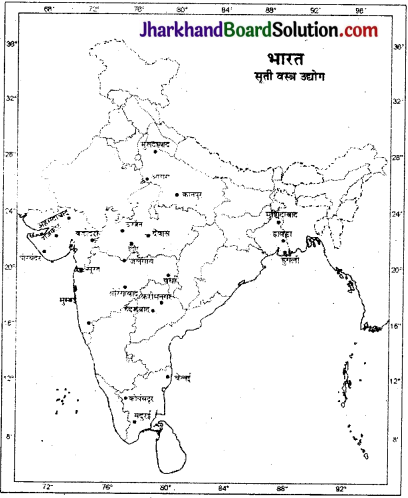
अन्तर्राष्ट्रीय व्यापार:
भारत में सूती वस्त्रों का निर्यात भी किया जाता है। भारत से सूती वस्त्रों का निर्यात जापान, संयुक्त राज्य अमेरिका, इंग्लैण्ड, फ्रांस, पूर्वी यूरोपीय देश, श्रीलंका, नेपाल, सिंगापुर एवं अफ्रीकी देशों को किया जाता है।
![]()
प्रश्न 3.
भारत में लोहा और इस्पात उद्योग का विस्तार से वर्णन कीजिए।
उत्तर:
लोहा और इस्पात उद्योग एक आधारभूत उद्योग है, क्योंकि अन्य सभी भारी, हल्के एवं मध्यम उद्योग इससे बनी मशीनरी पर निर्भर हैं। वर्तमान युग को इस्पात युग कहा जाता है। लौह इस्पात उद्योग से ही सभी उद्योगों में कार्यरत मशीनों, परिवहन के साधनों एवं इंजीनियरिंग का सामान तैयार किया जाता है।
1. लोहा और इस्पात उद्योग के विकास की दशाएँ:
इस्पात के उत्पादन एवं खपत को प्रायः एक देश के विकास का पैमाना माना जाता है। लोहा और इस्पात उद्योग एक भारी उद्योग है क्योंकि प्रयुक्त कच्चा एवं तैयार माल दोनों ही भारी व स्थूल होते हैं तथा इसके लिए अधिक परिवहन लागत की आवश्यकता होती है।
इस उद्योग के लिए लौह अयस्क एवं कोकिंग कोयले के अतिरिक्त चूना-पत्थर, डोलोमाइट, मैंगनीज एवं अग्निसह मृत्तिका आदि कच्चे माल की आवश्यकता होती है। इस उद्योग के लिए लौह अयस्क, कोकिंग कोयले एवं चूना पत्थर का अनुपात लगभग 4 : 2 : 1 का है। इस उद्योग की स्थापना में सक्षम परिवहन की आवश्यकता होती है।
2. लोहा और इस्पात निर्माण की प्रक्रिया:
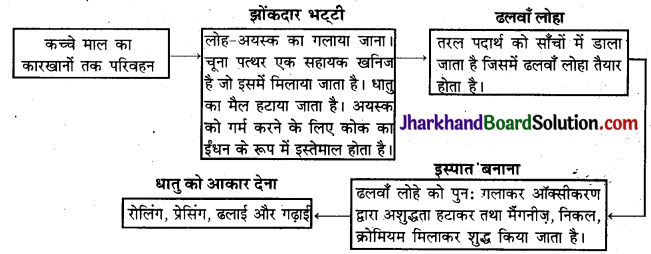
3. लोहा इस्पात उद्योग का स्थानीयकरण:
भारत में लोहा और इस्पात उद्योग का सर्वाधिक केन्द्रीकरण छोटा नागपुर के पठारी क्षेत्र में हुआ है। छोटा नागपुर के पठारी क्षेत्र में इस उद्योग के विकास के लिए अधिक अनुकूल सापेक्षिक परिस्थितियाँ हैं। इनमें लौह अयस्क की कम लागत, उच्च किस्म के कच्चे माल की निकटता, सस्ते श्रमिक एवं स्थानीय बाजार में इसकी माँग की विशाल सम्भाव्यता आदि हैं।
4. भारत में लोहा और इस्पात के कारखाने:
वर्तमान में भारत में 10 मुख्य संकलित उद्योग एवं अनेक छोटे इस्पात संयन्त्र हैं। भारत में लोहा इस्पात उद्योग की प्रमुख इकाइयाँ निम्नलिखित हैं
- टाटा लौह इस्पात कम्पनी (टिस्को)-जमशेदपुर (झारखण्ड),
- भारतीय लोहा और इस्पात कम्पनी (इसरो)-हीरापुर, कुल्टी व बर्नपुर,
- विश्वेश्वरैया, आयरन एण्ड स्टील वर्क्स-भद्रावती (कर्नाटक),
- राउरकेला इस्पात संयन्त्र-राउरकेला (ओडिशा),
- भिलाई इस्पात संयन्त्र, भिलाई (छत्तीसगढ़),
- दुर्गापुर इस्पात संयन्त्र-दुर्गापुर (प. बंगाल),
- बोकारो इस्पात संयन्त्र-बोकारो (झारखण्ड),
- सलेम इस्पात संयन्त्र-सेलम (तमिलनाडु),
- विजाग इस्पात संयन्त्र- विशाखापट्टनम् (आन्ध्र प्रदेश),
- विजयनगर इस्पात संयन्त्र-विजयनगर (कर्नाटक)। सार्वजनिक क्षेत्र के लगभग समस्त. कारखाने अपने इस्पात को स्टील अथॉरिटी ऑफ इण्डिया (सेल-SAIL) के माध्यम से बेचते हैं जबकि टिस्को (TISCO) टाटा स्टील के नाम से अपने उत्पाद को स्वयं बेचती है।
5. उत्पादन एवं अन्तर्राष्ट्रीय व्यापार:
वर्ष 2019 में भारत 111.5 मिलियन टन इस्पात का विनिर्माण करके विश्व में कच्चे इस्पात उत्पादक देशों में दूसरे स्थान पर था। यह स्पंज लौह का सबसे बड़ा उत्पादक देश है। सन् 1950 के दशक में भारत एवं चीन ने लगभग एक समान मात्रा में इस्पात उत्पादित किया था। वर्तमान समय में चीन इस्पात का सबसे बड़ा उत्पादक एवं खपत वाला देश है।
6. लोहा और इस्पात उद्योग की समस्याएँ:
यद्यपि भारत विश्व का एक महत्वपूर्ण लोहा और इस्पात उत्पादक देश है लेकिन हम इसके पूर्ण सम्भाव्य का विकास नहीं कर पाये हैं। इसके प्रमुख कारण निम्न हैं
- उच्च लागत एवं कोकिंग कोयले की सीमित उपलब्धता।
- न्यून श्रमिक उत्पादकता।
- ऊर्जा की अनियमित आपूर्ति।
- अविकसित अवसंरचना आदि।
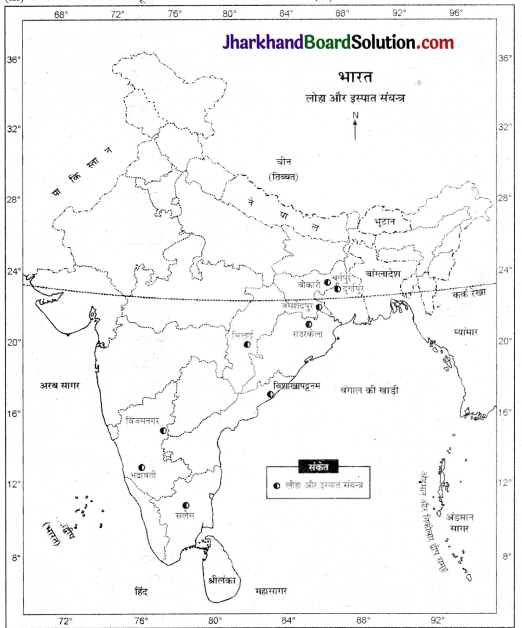
प्रश्न 4.
जल प्रदूषण के क्या कारण हैं? इसे दूर करने के उपाय सुझाइए।
उत्तर:
- जल प्रदूषण के निम्नलिखित कारण हैं
- औद्योगिक कारखानों की गन्दगी से नदियों का जल अशुद्ध हो जाता है।
- नदियों में मृत जानवरों की लाशों तथा मृत व्यक्तियों की अस्थियों से जल अशुद्ध हो जाता है।
- मल-मूत्र का त्याग करने से व पशुओं को नदियों में नहलाने से जल दूषित हो जाता है।
- नदी के किनारे के खेतों में दी गई खाद से भी जल दूषित होता है।
- नदी व तालाबों में चारों ओर धूल व पेड़ों की पत्तियाँ आदि पड़ी रहती हैं जिससे जल प्रदूषित होता है।
- तालाब का जल स्थिर होता है अत: उसमें कीड़े व मकोड़ों की संभावना काफी रहती है इसलिए जल प्रदूषित होता है।
- (जल प्रदूषण को दूर करने के उपाय:
- जो शहर नदियों के किनारे बसे हुए हैं, उन शहरों की जल आपूर्ति का मुख्य साधन नदियाँ हैं। अत: उनमें गन्दे नालों को गिरने से रोकना चाहिए।
- जहाँ हम जल का संग्रह करें वहाँ पर नहाने, धोने, जानवर नहलाने व गन्दे नाले मिलाने की मनाही होनी चाहिए।
- नदियों में कारखानों के रसायनयुक्त पानी को बहाने से रोकना चाहिए।
- तालाब ऐसे स्थान पर बनाने चाहिये जिसके आस-पास श्मशान, गन्दे पानी के गड्ढे, शौचालय व नालियाँ आदि न हों।
- तालाबों का बाहरी किनारा ऊँचा करवा देना चाहिए; जिससे बाहर का गन्दा जल उनमें न पहुँच पाये।
- तालाबों व नदियों में नहाने व कपड़े धोने पर रोक लगानी चाहिए; जिससे जल प्रदूषित न हो सके।
- नदियों व तालाबों के किनारे पर काँटों के तारों की रोक लगा देनी चाहिये; जिससे उनमें जानवर प्रवेश न कर सकें।
- प्रत्येक घर में प्राकृतिक जल संग्रहण हेतु व्यवस्था होनी चाहिए।
- पम्प द्वारा पानी लेने की व्यवस्था करनी चाहिए।
- तालाब में लाल दवाई का प्रयोग करते रहना चाहिए।
मानचित्र सम्बन्धी प्रश्न
प्रश्न 1.
दिए गए भारत के रेखा मानचित्र का अध्ययन कर निम्नलिखित प्रश्नों के उत्तर दीजिए
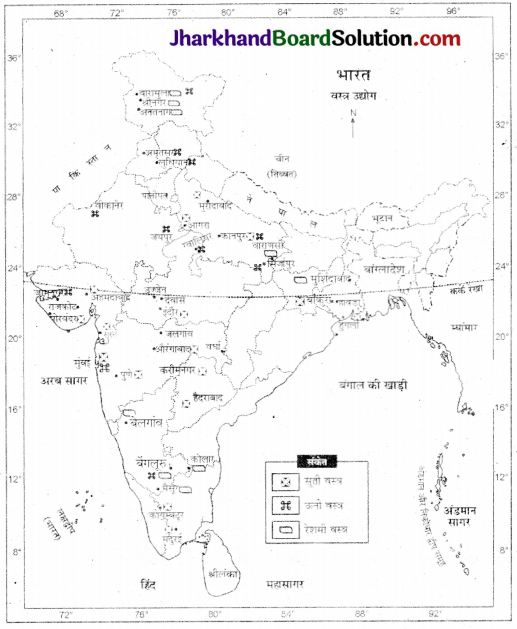
(i) किन्हीं चार सूती वस्त्र केन्द्रों के नाम लिखिए।
उत्तर:
मुम्बई, अहमदाबाद, कानपुर, मदुरई।
(ii) भारत के दो ऊनी वस्त्र केन्द्रों के नाम बताइए।
उत्तर:
मुम्बई, लुधियाना।
(iii) भारत के किन्हीं दो रेशम वस्त्र केन्द्रों के नाम बताइए।
उत्तर:
श्रीनगर, मैसूर।
(iv) किन दो राज्यों में सूती वस्त्र मिलों की अधिकतम संख्या है।
उत्तर:
महाराष्ट्र, गुजरात।
(v) दिए गये भारत के रेखा मानचित्र में निम्न को अंकित कीजिए
उत्तर:
- सूती वस्त्र उद्योग- पोरबन्दर।
- ऊनी वस्त्र उद्योग-बीकानेर।
(vi) भारत के रेखा मानचित्र में निम्नलिखित को दर्शाइए तथा उसका नाम लिखिए
उत्तर:
(क) इंदौर – सूती वस्त्र उद्योग
(ख) अहमदाबाद – सूती वस्त्र उद्योग केन्द्र
(ग) मुरादाबाद – सूती वस्त्र उद्योग
(घ) कोयम्बटूर – सूती वस्त्र उद्योग
![]()
प्रश्न 2.
दिए गए भारत के रेखा मानचित्र का अध्ययन कर निम्नलिखित प्रश्नों के उत्तर दीजिए(i) छत्तीसगढ़, पश्चिम बंगाल, तमिलनाडु, कर्नाटक एवं झारखण्ड प्रत्येक राज्य के एक-एक लोहा-इस्पात संयंत्र का नाम लिखिए।
(ii) निम्नलिखित राज्यों के लौह एवं इस्पात केन्द्रों को मानचित्र में पहचानें
(अ) कर्नाटक का एक इस्पात केन्द्र
(ब) छत्तीसगढ़ का एक इस्पात केन्द्र।
(iii) भारत के रेखा मानचित्र में निम्नलिखित को अंकित कीजिए:
(क) राउरकेला।
(iv) भारत के रेखा-मानचित्र में निम्नलिखित को दर्शाइए तथा उसका नाम लिखिए
1. भिलाई – लोहा और इस्पात संयंत्र
2. विजयनगर — लोह व इमामोद्योगिक केन्द्र
3. जमशेदपुर — लोहा और समान संयंत्र
4. भद्रावती – लोहा एवं इस्पात संयंत्र
5. दुर्गापुर – लोहा और इस्पात संयंत्र
6. बोकारो – लोहा और इस्पात संयंत्र ।
(v) दिए गए भारत के रेखा-मानचित्र में निम्नलिखित को अंकित कीजिए
सेलम, दुर्गापुर
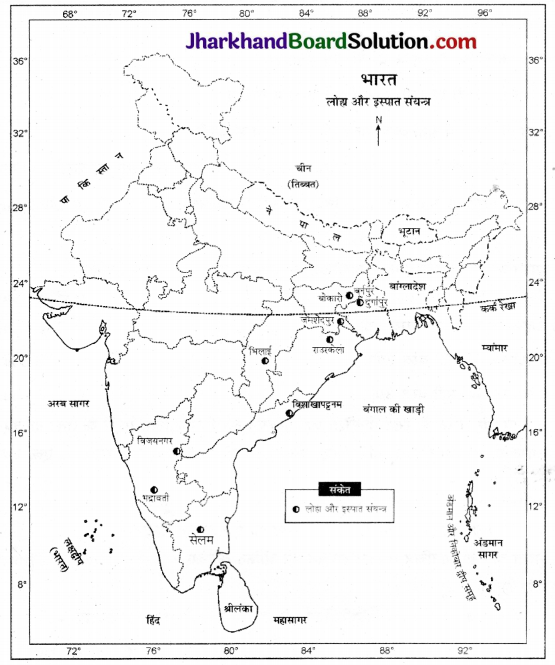
उत्तर:
विभिन्न राज्यों में स्थित लोहा और इस्पात संयंत्र:
- छत्तीसगढ़-भिलाई, पश्चिम बंगाल दुर्गापुर, बर्नपुर, तमिलनाडु सेलम, कर्नाटक भद्रावती, विजय नगर, झारखण्ड बोकारो, जमशेदपुर।
- (अ) कर्नाटक का एक इस्पात केन्द्र भद्रावती।
(ब) छत्तीसगढ़ का एक इस्पात केन्द्र भिलाई।
प्रश्न 3.
निम्नलिखित को भारत के मानचित्र में अंकित कीजिए।
(अ) सॉफ्टवेयर टेक्नोलॉजी पार्क:
मोहाली, नोएडा, जयपुर, गांधीनगर, दौर, मुम्बई, पुणे, कोलकाता, भुवनेश्वर, विशाखापत्तनम्, हैदराबाद, बेंगलूरु, मैसूरु, चेन्नई और थिरूवनंथपुरम।
अथवा
(ब) निम्नलिखित को भारत के राजनीतिक रेखा मानचित्र पर दर्शाइए और उसका नाम लिखिए। विशाखापट्टनम- सॉफ्टवेयर प्रौद्योगिकी पार्क।
(स) निम्नलिखित को भारत के राजनीतिक रेखा मानचित्र पर दर्शाइए और उसका नाम लिखिए। पश्चिमी बंगाल का सॉफ्टवेयर टेक्नोलॉजी पार्क
उत्तर:
कोलकाता
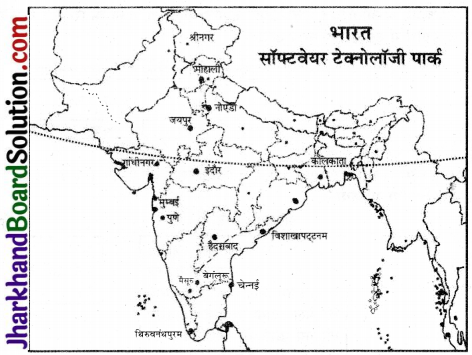
तालिका सम्बन्धी प्रश्न
प्रश्न 1.
उद्योग-बाजार सम्बन्ध को दर्शाने वाली तालिका के रिक्त 1 और 2 स्थानों की पूर्ति कीजिए।
उत्तर:

1. कारखाना, 2. पूँजी।
प्रश्न 2.
उद्योग की आदर्श अवस्थिति दर्शाने वाली तालिका के रिक्त स्थान 1 की पूर्ति कीजिए।
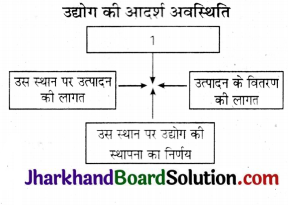
उत्तर:
उस स्थान पर कच्च माल प्राप्त करने की लगत ।
प्रश्न 3.
वस्त्र उद्योग में अतिरिक्त मूल्य उत्पाद दर्शाने वाली तालिका के रिक्त 1 व 2 स्थानों की पूर्ति कीजिए। उत्तर वस्त्र उद्योग में अतिरिक्त मूल्य उत्पाद:

उत्तर:
1. रेशा उत्पादन, 2. कपड़ा।
प्रश्न 4.
इस्पात निर्माण प्रक्रिया दर्शाने वाली तालिका के रिक्त स्थान 1 व 2 की पूर्ति कीजिए।
उत्तर:
इस्पात निर्माण प्रक्रिया:
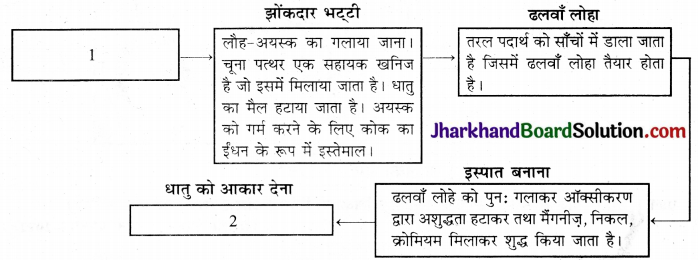
उत्तर:
1. कच्चे माल का कारखानों तक परिवहन,
2. रोलिंग, प्रेसिंग, ढलाई और गढ़ाई।
प्रश्न 5.
एल्यूमिनियम उद्योग में विनिर्माण की प्रक्रिया को आरेख द्वारा स्पष्ट कीजिए।
उत्तर:
एल्यूमिनियम उद्योग में विनिर्माण की प्रक्रिया
